El lugar habitado más inaccesible de la Tierra.
Una isla perdida en el medio del océano Atlántico:
"Tristán da Cuña"
Es un archipiélago británico compuesto por varias islas. La mayor con el mismo nombre, y otras llamadas Inaccesible y Ruiseñor. Se encuentra ubicado en el Atlántico Sur junto con la isla Gough, todo esto constituye una dependencia de la isla de Santa Elena.
The most inaccessible inhabited place on Earth.
An island lost in the middle of the Atlantic Ocean:
"Tristán da Cuña"
It is a British archipelago made up of several islands. The oldest with the same name, and others called Inaccessible and Nightingale. It is located in the South Atlantic along with Gough Island; all this constitutes a dependency of the island of St. Helena.
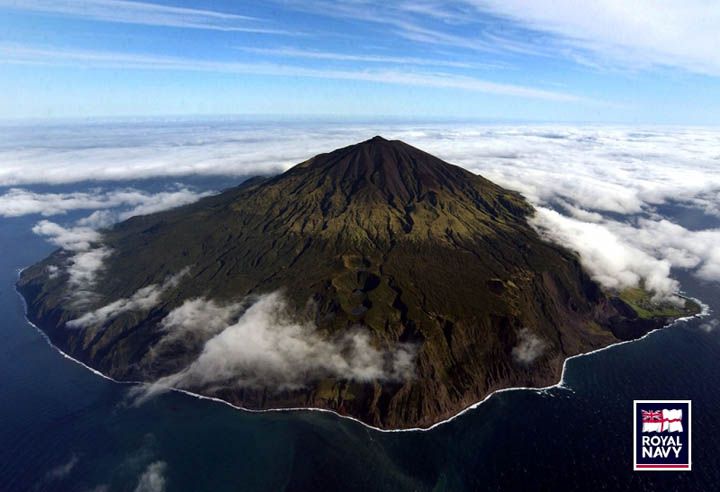
Imagen de la isla desde arriba, tomada de google imagenes.
Image of the island from above, taken from google images.
Santa Elena, es el lugar más cercano habitado, y se encuentra a una distancia de 2173 km al norte. Esta es conocida debido a que sirvió de prisión militar al exiliado emperador Napoleón I de Francia, desde su derrota en la Batalla de Waterloo en 1815 hasta su muerte, en 1821.
La isla principal es de origen volcánico, su relieve es muy montañoso, solo hay una pequeña planicie en la zona noroccidental, donde se encuentra Edimburgo de los 7 mares. ¿Por qué la isla cuenta con este récord si hay lugares más alejados? Porque no hay aeropuerto.
Santa Elena, is the closest inhabited place, and is located at a distance of 2173 km to the north. This is known because it served as a military prison to the exiled Emperor Napoleon I of France, from his defeat at the Battle of Waterloo in 1815 until his death in 1821.
The main island is of volcanic origin, its relief is very mountainous, there is only a small plain in the northwestern area, where Edinburgh of the 7 seas is located. Why does the island have this record if there are more remote places? Because there is no airport.
¿Cómo llegar hasta la isla?
El acceso a Tristán es tremendamente complicado. Primero por su lejanía, y segundo porque está rodeada de acantilados de 600mts de altura. Tiene una población de 270 personas. Además, la isla cuenta con el récord Guinness del lugar más alejado de otro que este habitado.
Así es, para llegar ahí no es nada fácil, la única manera de hacerlo es por vía marítima, aproximadamente tomaría una semana. Angel, ¿una semana navegando? ¿Es un crucero? Ojalá, pero no lo es. Primero, desde donde estés tienes que llegar a Ciudad del Cabo en Sudáfrica.
Después de que estés ahí, tienes que tener muchísima suerte para encontrar puesto disponible en el único barco que zarpa 8 veces al año a la isla, y tiene puesto solo para 12 personas. Prioridades en la lista:
-Médicos.
-Oficiales.
-Residentes.
-Familiares de residentes.
-Tu.
How to get to the island?
Access to Tristan is tremendously difficult. Firstly because of its remoteness, and secondly because it is surrounded by 600m high cliffs. It has a population of 270 people. In addition, the island has the Guinness record for the farthest place from another that is inhabited.
That's right, to get there is not easy, the only way to do it is by sea, it would take approximately a week. Angel, a week sailing? Is it a cruise ship? Hopefully, but it isn't. First, from wherever you are you have to get to Cape Town in South Africa.
After you are there, you have to be very lucky to find a position available on the only ship that sails 8 times a year to the island, and has a position for only 12 people. Priorities on the list:
-Doctors.
-Officials.
-Residents.
-Families of residents.
-You.
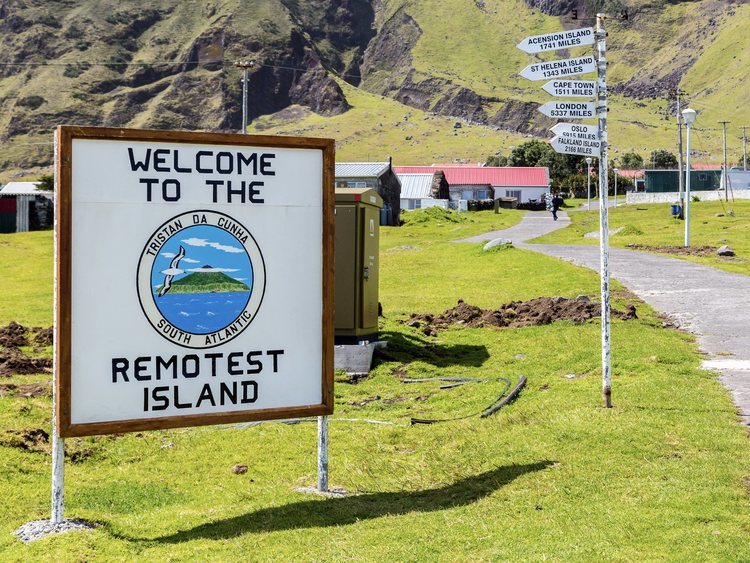
Cartel al llegar al pueblo principal, tomada de google imagenes.
Poster when arriving at the main town, taken from google images
¿Quien la descubrio?
La isla como tal fue descubierta por el navegante portugués "Tristán Da Cunha", aunque no puso ni un pie en ella, no tenía por dónde acceder. Empezó a ser habitada apenas en el siglo XIX de manera estable cuando fue tomada por la corona Británica en 1816.
Los británicos no querían que los franceses utilizaran esta isla como base para rescatar a Napoleón, que estaba en la isla de Santa Elena. ¡No en mi guardia!, dijeron los Británicos.
La isla está ubicada en un punto donde cualquier lugar queda a más de 2 mil kilómetros a la redonda. Suramérica a 3360 km, Sudáfrica 2816 km, Santa Elena 2100km. El lugar más alto de la isla es el pico de la Reina María, el volcán de la isla.
Con una altura de 2062 mts es el centro de la isla y se encuentra rodeado de nieve en invierno.
Who discovered?
The island as such was discovered by the Portuguese navigator "Tristán Da Cunha", although he did not set foot on it, he had no where to access. It began to be inhabited only in the 19th century in a stable way when it was taken over by the British crown in 1816.
The British did not want the French to use this island as a base to rescue Napoleon, who was on the island of Saint Helena. Not on my guard! Said the British.
The island is located at a point where any place is more than 2,000 kilometers around. South America 3360 km, South Africa 2816 km, Santa Elena 2100km. The highest place on the island is the peak of Reina María, the island's volcano.
With a height of 2062 meters, it is the center of the island and is surrounded by snow in winter.
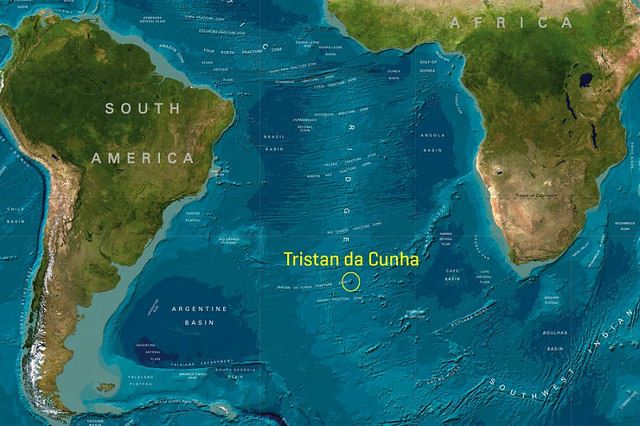
Mapa mundi mostrando la isla, imagen tomada de google imagenes.
World map showing the island, image taken from google images.
¿Y los turistas?
Como van muy pocos turistas al año, la principal actividad económica es la venta de postales y estampillas, hay de la isla, de sus costumbres y hasta de sus catástrofes. Estos son distribuidos por correo a coleccionistas alrededor del mundo.
What about tourists?
As very few tourists go a year, the main economic activity is the sale of postcards and stamps, there are of the island, its customs and even its catastrophes. These are distributed by mail to collectors around the world.
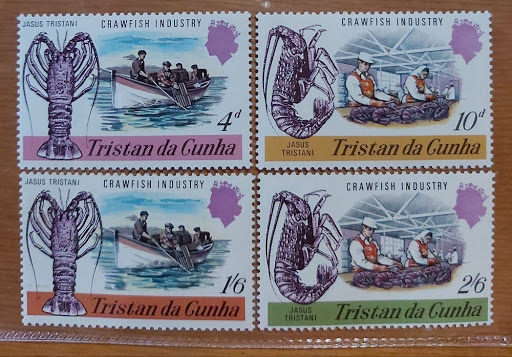
Estampillas de la isla, imagen tomadad de google imagenes.
Stamps of the island, image taken from google images.
¿COVID?
En este tiempo de pandemia debido a su difícil acceso no ha llegado el Covid-19, y esperemos que no llegue. ¡Ellos ya sabían lo que venía, por eso se devolvieron! Un lugar curioso que vale la pena conocer.
And the COVID?
In this time of pandemic, due to its difficult access, Covid-19 has not arrived, and we hope it does not. They already knew what was coming, that's why they returned! A curious place that is worth knowing.
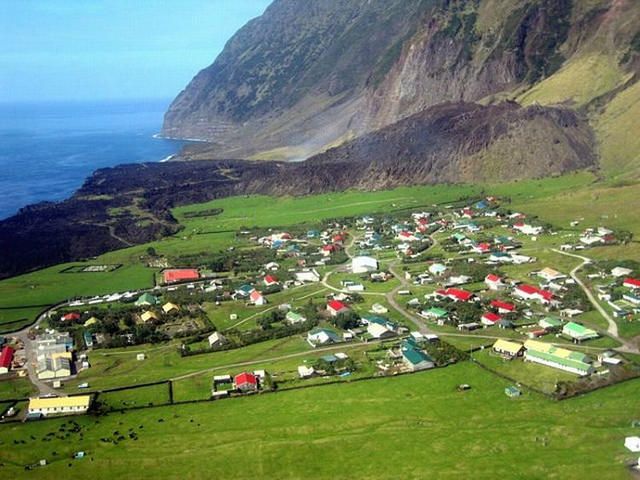
Foto del pueblo principal, tomada de google imagenes.
Photo of the main town, taken from google images.
Eso fue todo, espero les haya gustado todo lo que les conte sobre estre increible sitio, mis proximos post seran de cosas aun mas interesantes asi que esperenlos.
That was it, I hope you liked everything I told you about this incredible site, my next post will be about even more interesting things so wait for them.
Congratulations @baraco! You have completed the following achievement on the Hive blockchain and have been rewarded with new badge(s) :
Your next target is to reach 50 upvotes.
You can view your badges on your board and compare yourself to others in the Ranking
If you no longer want to receive notifications, reply to this comment with the word
STOPSupport the HiveBuzz project. Vote for our proposal!